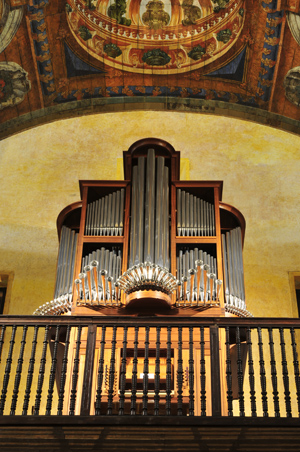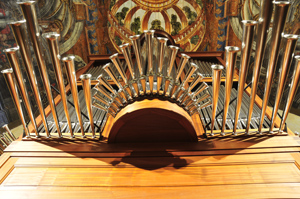 Wednesday, 24 October, 9.30, p.m.
Wednesday, 24 October, 9.30, p.m.
Church of São João Evangelista (Colégio)
Michel Bouvard, organ
This recital programme is centred very clearly around German music. However, I wanted to offer an 'aperitif' by means of some French pieces from the 16th and 17th centuries, which will enable us to hear the different registers of the instrument.
The Danceries by Claude Gervaise and other, anonymous, composers of the 16th century are the oldest musical works printed in France. They were intended for the small instrumental groups of the time, but they work extremely well on the organ. These Danceries of the renaissance (the various kinds of bransles danced in high society) have a most captivating character in the dynamic contrasts obtainable on the organ, not only by means of the registration but by the way in which the keyboard is used.
Louis Couperin was the uncle of the great François Couperin. Organist and violist of the King, he represents, in the mid-17th century in France, the union between the 'old' contrapuntal music (Titelouze, Du Caurroy) and the 'modern' music influenced by opera, recitative and accompanied melody (Nivers, Lebègue, Grigny, Marchand...). He was the author of the first Basses de tierce, which would give rise to the Basses de trompette and which imitate the Basses de viole. I have chosen four of his Fantaisies pour l’orgue, miniatures of great sophistication in the form of fugues or accompanied solos.
The German part of the programme, which leads us to Johann Sebastian Bach, begins with the great North German school, with a Prelude by Heinrich Scheidermann, an organist from Hamburg from the first generation of Sweelinck’s pupils in Amsterdam. There follows an obligatory visit to the greatest composer for organ before Bach, Dieterich Buxtehude, whom the young Cantor went to visit at the age of twenty in Lübeck, walking the hundreds of kilometres from central Germany. Two typical works by the great master will be heard: the Passacaglia in D minor, a work full of symbolism which inspired Bach’s Passacaglia, and a choral prelude on the Advent theme Nun komm, der Heiden Heiland. Bach also wrote his own ornamented chorale based on this work, found in the Leipzig collection. Bach’s chorale, sublime and imposing in its dimensions, is, in some ways, the “development” of that by Buxtehude. For this reason, we will hear this work immediately afterwards. There follow two further chorale preludes, both by Bach, on another, deeply moving, Lutheran melody, Liebster Jesu, wir sind hier. In contrast, there follows the famous Pièce d'Orgue, which includes tempo and other indications written by Bach in French (vitement). This piece is, it is said, an evocation of the three stages of human life: youth, maturity, old age. Do the last line and final cadence perhaps suggest the blessedness of eternal life?
To finish this concert, I wanted to suggest the romantic world. Though German romantic composers such as Mendelssohn and Schumann wrote some original works for organ, their creative genius was reserved principally for the piano, in works of the highest calibre. The temptation to “borrow” these works has always existed for organists, and there have been numerous transcriptions over the years. Here, then, is the most beautiful transcription of the Variations sérieuses, without doubt the most famous of Mendelssohn’s piano works. This transcription was made by the organist Reitze Smits, who did not hesitate, like Bach in his transcriptions of Vivaldi’s concertos, to modify the writing in certain passages, usually simplifying them with the intention of making them work better on the organ. Each one of the seventeen variations makes use of a different registration and dynamic. One might say that Mendelssohn himself would not reject this adaptation of his masterpiece for the organ.
Michel Bouvard
Organ Recital
Claude Gervaise and anonymous 17th century
Dances from the French Renaissance
Branle de Champaigne
Branle de Bourgogne
Allemande
Branle gay
Branle simple
Louis Couperin (1626-1661)
Fantaisie nº 26
Fantaisie nº 12
Fantaisie nº 58 sur la tierce du grand clavier, avec le tremblant lent
Fantaisie nº 59
Heinrich Scheidemann (1595-1663)
Praeambulum in d
Dietrich Buxtehude (1637-1707)
Passacaglia in D minor Bux WV 161
Chorale Prelude Nun komm der Heiden Heiland BuxWV 211
Johann Sebastian Bach (1685-1750)
Chorale Prelude Nun komm’ der Heiden Heiland (orné) BWV 659
Chorale Prelude Liebster Jesu, wir sind hier BWV 730
Chorale Prelude Liebster Jesu, wir sind hier BWV 731
Pièce d’orgue BWV 572
Felix Mendelssohn-Bartholdy (1809-1847)
Variations sérieuses, Op. 54 (organ transcription by Reitze Smits)
Participants
|
Was born in 1958 in Lyon. His grandfather, Jean Bouvard (a pupil of Louis Vierne) passed on his passion for music. After studying piano in Rodez and Paris, he worked wirh Suzane Chaisemartin, subsequently taking André Isoir’s class in Orsay. He finished his training with the organists of Saint-Séverin (Jean Boyer, Francis Chapelet, Michel Chapuis), before himself becoming titular organist of that instrument. A first prize in the Toulouse International Competition (1983) marked the beginning of his career. Asked by Xavier Darasse to take over his organ class at the Toulouse Conservatoire, he works assiduously for the maintenance of the city’s historical organs, organizing with his colleague Jan Willem Jansen concerts, visits, seminars and international competitions. This work culminated in the creation, in 1996, of the Touluse-les-orgues International Festival. He is titular organist of the historical instrument at Saint-Sernin in Toulouse. Internationally known, he is invited to participate in the juries of great organ competitions, and his concert and teaching career takes him regularly to some twenty countries in Europe, Asia and on the American continent. |
Notes about the Organ
 Church São João Evangelista (Colégio), Funchal
Church São João Evangelista (Colégio), Funchal
This instrument, with 1586 sounding pipes, is situated in a religious space with certain particularities. As a church typical of those belonging to Jesuit colleges, with a broad nave and quite a gentle acoustic, the organ had to be specially conceived, especially with regard to the measurements of the pipes. Thus all the pipework of the instrument has been specifically tailored to produce a full sound, and each stop produces a timbre with an individual personality, forming part of a harmonic ensemble based more on the sound of fundamentals and less on harmonics. It was also felt to be essential to give the instrument a certain ‘latin’ sonority that would favour performance of ancient music of the Italian, Spanish and Portuguese schools of the 17th and 18th centuries.
Another aspect to be taken into consideration was the need to complement the current range of organs available locally: the new organ responds in an ideal fashion to the performance of works of periods and of technical and artistic requirements that none of the 24 historic instruments of Madeira cater adequately for. It also enhances the range of organs that constitute the island’s heritage by being present in this particular religious space, as well as by existing side by side with other historical instruments. In the decision to build it for this church, not only were the issues of acoustic, aesthetic and liturgical space taken into account, but also the presence there of an important historic instrument which is currently on the list of instruments undergoing restoration.
I Manual - Órgão Principal (C-g’’’)
Flautado aberto de 12 palmos (8’)
Flautado tapado de 12 palmos (8’)
Oitava real (4’)
Tapado de 6 palmos (4’)
Quinzena (2’)
Dezanovena e 22ª
Mistura III
Corneta IV
Trompa de batalha* (bass)
Clarim* (treble)
Fagote* (bass)
Clarineta* (treble)
II Manual - Órgão Positivo (C-g’’’)
Flautado aberto de 12 palmos (8’)
Tapado de 12 palmos (8’)
Flautado aberto de 6 palmos (4’)
Dozena (2 2/3’)
Quinzena (2’)
Dezassetena (1 3/5’)
Dezanovena (1 1/3)
Címbala III
Trompa real (8’)
Pedal (C-f’)
Tapado de 24 palmos (16’)
Bordão de 12 palmos (8’)
Flautado de 6 palmos (4’)
Contrafagote de 24 palmos (16’)
Trompa de 12 palmos (8’)
Couplers
II/I
I/Pedal
II/Pedal
* horizontal reeds
 Michel Bouvard
Michel Bouvard